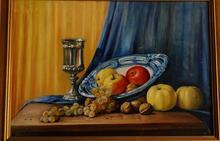Broncia Koller-Pinell
Self portrait by Broncia Koller-Pinell. Image via Wikimedia Commons.
As an artist and Jewish woman at the turn of the twentieth century, Broncia Koller-Pinell defied conventions by marrying Hugo Koller, a Catholic physician and physicist, and actively working in circles around the Wiener Werkstätte and the Secession. Raised by Orthodox Jewish parents, Koller-Pinell stayed true to her Jewish faith as she lived and worked among Christians and often faced antisemitism. Her art was stylistically influenced by Gustav Klimt and French trends, and she concentrated on creating landscapes, still lifes, and portraits that repeatedly depicted religious themes. Koller-Pinell exhibited her work at Vienna’s leading Gallery Miethke and developed a prominent creative voice despite the constraints of her social position.
Early Life and Family
Broncia Koller-Pinell was born in Sanok (Galicia) on February 23, 1863, to Orthodox Jewish parents, Klara and Saul Pineles (?–1903). Broncia was one of five children who included Dr. Stanislaus Pineles, a lawyer and lecturer at the University of Vienna, and Friedrich Pineles, a physician at the Wiener Allgemeine Krankenhaus and later head of the Franz-Josefs Ambulatorium. Her father, an architect of military fortifications, moved to Vienna with his family in 1870. According to Broncia Koller’s daughter, Silvia Koller, Saul Pineles supported her mother’s artistic aspirations.
At the age of eighteen Broncia Koller began private studies under the sculptor Josef Raab (?–1883) and after his death in 1883 continued under the painter Alois Delug (1859–1930). This was followed by a five-year sojourn in Munich to study in the ateliers of Ludwig Heterich (1856–1932) and Ludwig Kühn (1859). Koller began exhibiting in 1888 at the International Art Exhibition in Vienna, but had her first success with shows in 1892 at the Künstlerhaus in Vienna, in 1893 at the Glaspalast in Munich and in 1894 at the Kunstverein in Leipzig. In 1896, despite the objection of her family, she married Hugo Koller (1867–1942), a Catholic physician and physicist. They lived first in Salzburg and then in Nuremberg where both her children, Ruppert and Silvia, were born. They were raised as Christians, although Broncia did not convert. In 1903 the family resettled in Vienna and actively participated in the circles around the Wiener Werkstätte and the Secession. Many artists, such as Josef Hoffmann (1831–1904), Kolo Moser (1868–1918), and Gustav Klimt (1862–1918), as well as philosophers, musicians, and scholars gathered at their house. Broncia Koller had especially close ties to Klimt’s group and exhibited with them in 1908 and 1909 at the Kunstschau and in 1911 at Vienna’s leading Gallery Miethke. In 1913 she became a member of the Bund österreichischer Künstler founded by Klimt, Moser, Hoffman, and others.
Artistic Achievement and Religious Tensions
Despite her artistic accomplishments, her critics and even her friends labeled her with the stigma of being simply “the talented wife of a prominent husband” (Gütersloh 1934). Like all Jewish women artists of her time, Broncia Koller was a captive of her traditional female role. Her artistic creativity was often tolerated in view of her social position. Though she participated in numerous national and international exhibitions throughout her life, she was never really accepted among her male colleagues, both because she was a woman and because she was prosperous.
Her artistic development was stylistically influenced by Klimt but she also responded to international, especially French, trends. Thematically, she concentrated on landscape, still life, genre, and portraits, but she also repeatedly depicted religious themes such as “Abraham and the Three Angels,” “Flight” or “Afternoon with Grandmother.” The latter displays a picture of a Madonna with child, a baptismal font, a crucifixion, and prayer beads. This led a scholar to the premature assumption that “Broncia Koller obviously viewed herself less as a Jew than as a member of the Christian cultural circle” (Baumgartner 1989). However, Broncia Koller remained true to her religion throughout her life. She remained faithful at a time of increasing tension when riots and antisemitic demonstrations were common practice, when Jew-hatred was an integral part of politics and when anti-Jewish talk overflowed from public demagogy and family prejudices into daily life.
Thus, Broncia Koller-Pinell created her art in an environment suffused both with public and family antisemitism. She died on April 24, 1934, in Oberwaltersdorf, Austria.
Peter Baum (ed.): Secession and Austrian Graphic Art 1900–1920. Vienna: 1993: 70.
Baumgartner, Sieglinde. “Broncia Koller-Pinnell 1863–1934: Eine österreichische Malerin zwischen Dilettantismus und Profession.” Ph.D. diss., Salzburg: 1989: 126.
Gütersloh, Albert Paris. “Broncia Koller.” Obituary in Wiener Zeitung, April 29, 1934.
Cat. Broncia Koller. Neue Galerie der Stadt, Linz: 1983.
Cat. Broncia Koller. Österreichische Staatsdruckerei, Vienna: 1961, 3.
Cat. Broncia Koller Pinell: Eine Malerin im Glanz der Wiener Jahrhundertwende. Ed. by Tobias Natter. Jewish Museum, Vienna: 1993.
Cat. Die Malerin Broncia Koller, 1863–1934. Niederösterreichisches Landesmuseum, Vienna: 1980.
Letter by Albert Paris Gütersloh to Felix Albrecht Harta, dated June 26, 1919. Quoted in Fuhrmann, Franz: “Anton Faistauer: Briefe an Felix Albrecht Harta.” Jahresschrift Salzburger Landesmuseum Carolina Augusteum. Salzburg: 1961, 61.
Letter of Gustavine Koller, née Edle von Kleinmayer, dated February 21, 1896 (Firma Eisenberger KG). Quoted in Natter, Broncia Koller, 19–20.




